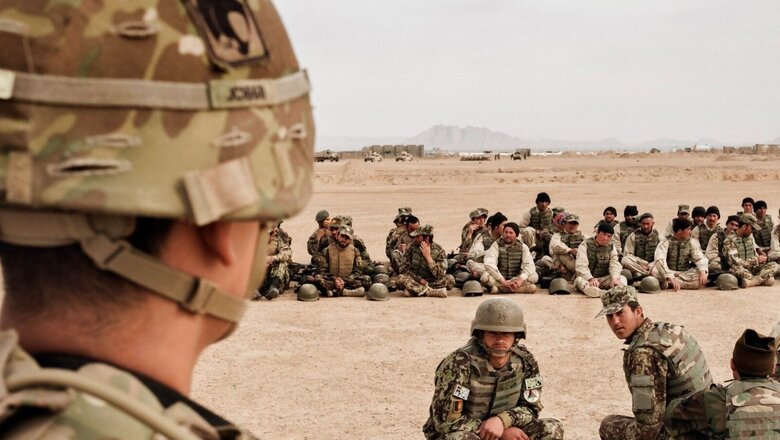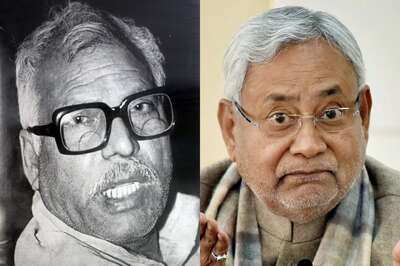
views
The events in Afghanistan have underscored something that has always been staring at us in the face: There is a vast gulf that separates India and United States’ (US) interests in the Indo-Pacific. We are assuming here the Indian definition of Indo-Pacific, which is geographic, rather than political and as last spelt out by Prime Minister Modi in 2018, essentially sees a region stretching from “the shores of Africa to that of the Americas.”
The US notion of the Indo-Pacific differs as it begins from the western shores of India to those of the Americas.
The Indo-US strategic partnership does not include the western Indian Ocean and its hugely important littoral, which includes the Saudi peninsula, East Africa, and the key continental concerns which lie in what is virtually the fulcrum of Eurasia—Iran, Afghanistan, Pakistan, and Central Asia.
So, it was not surprising that our Indo-Pacific strategic partner kept us out of the Doha process, did not see it useful to have us in its now still-born western Quad comprising US, Pakistan, Afghanistan, and Uzbekistan. In these circumstances, there was no question of keeping India abreast with the developments in Afghanistan, including the nitty-gritty of the US plans to retreat from there. This, despite the fact that whatever we did in the country—which was not insubstantial in terms of reconstruction efforts—depended crucially on the American security umbrella.
For this reason, the South Block seems to be in an overdrive to show that the US-India strategic partnership is alive and well and has even been flourishing in the chaos of Kabul. Efforts are being made to show how much coordination and cooperation India got from the US to complete its diplomatic evacuation from the city. While the key role played by the Taliban in facilitating the move has been played down or ignored.
Looking into the future now one wonders whether a coherent Indo-Pacific policy is even possible. Having left Afghanistan, the way they did, the US is not likely to be in a hurry to make fresh commitments in the region.
From the US point of view, a departure from the Middle-East region makes sense. The Americans no longer depend on oil from that fractious region. Today, their principal concern is probably merely the security of Israel. This will actually help them focus on their competition with China in their definition of the Indo-Pacific region.
But geography, the immovable part of geopolitics, requires that India remain where it is. And from there, the Afghan disaster does not look not pretty. In Afghanistan, we had little choice, but we cannot avoid the blame for having burnt our bridges with Iran at the instance of the US. Don’t be surprised now if the US actually resumes its deal with Iran, while Tehran vents its ire on India for its pusillanimity, by denying us access to Chahbahar whose utility to India, in any case, now remains moot.
But the greater setback New Delhi has suffered is in Afghanistan where it has considerable goodwill amongst the populace and close ties with the government. This included cooperation with its intelligence service, the National Directorate of Security (NDS), through which it could mount operations in Pakistan.
Just how much influence Pakistan will have with the new Taliban is difficult to gauge despite having facilitated their resurgence with arms, money, and a safe haven. The Taliban, however, have opened pathways to Iran and Russia, ensuring that Islamabad’s hold on their logistics will be reduced. People like Mullah Baradar, who was detained and ill-treated by the Pakistanis for eight years have long memories. But the Pakistanis have an important trump card in the Haqqani network, which is now perhaps the strongest element in the coalition that makes up the Taliban.
India’s western headaches are likely to increase as Pakistan and China enhance their cooperation and seek to include Afghanistan in their new trilateral. In a phone call on Wednesday, Chinese foreign minister Wang Yi laid out four suggestions to his Pakistani counterpart Shah Mehmood Qureshi. First, on the need to support the establishment of a broad-based, inclusive political structure in Afghanistan; second, to support the process that will ensure that the country does not become a haven for terrorism again; third, on the importance of the safety and security of Chinese and Pakistani personnel in Afghanistan; and fourth, promoting international cooperation involving Afghanistan.
On the same day, Xi Jinping called President Ebrahim Raisi of Iran and President Barham Salih of Iraq separately. With Iran, Xi expressed strong support for bilateral cooperation and opposition to “external interference”. In addition, he supported Iran’s “legitimate concerns” over the comprehensive nuclear agreement.
Whatever may be Pakistan’s goals, China will not be interested in stirring up trouble in Afghanistan. Its approach is defensive, aimed at preventing any spillover of either American power or Islamist radicalism in Central Asia. Beijing has substantial financial investments in Central Asia, Iran, and Pakistan as part of its Belt and Road Initiative (BRI), and now its goal would be to incorporate Afghanistan into it as well.
Already there have been reports on how China may exploit the US $1 trillion of minerals, especially rare earths which Afghanistan has. According to Global Times, the Chinese are committed to the Afghan mining sector since 2009 and that they already have some US $630 million of direct investment in the mining communications and road communications sector there, along with US $0.5 billion of trade.
Indian investments and trade are much greater than that of China currently. India has built roads, dams, electricity transmission lines, sub-stations, schools, hospitals, gifted buses, and trained personnel. India and Iran had joined hands to exploit the Hajigak mining deposits as well. But now there will be a big question mark there. The Afghans will view this through the new geopolitical lenses that any new regime in Kabul will wear, and, of course, vice versa.
Already, we are witnessing little shifts in geopolitical developments that give us little comfort. Besides the deepening of the China-Pakistan relationship, there is increased American interest in Islamabad. The US indicated a desire to establish counterterrorism bases in Pakistan, but when Islamabad firmly pushed back on that score, the US backed off. But given Washington’s long investment in Pakistan, that is not likely to be the end of the story.
On the other side of the Indo-Pacific, both the US and China continue to spar, most recently at the ASEAN Regional Forum (ARF). While the meeting was addressed by Wang Yi and Antony Blinken, India chose to field the Junior Minister of External Affairs Rajkumar Ranjan Singh. Wang revealed that a tentative agreement had been reached at an earlier ministerial meeting on a Code of Conduct that China is negotiating with the ASEAN for over 20 years. What Wang was seeking to do was to show that China and the ASEAN were for a diplomatic solution to the problems of the South China Sea, in contrast to the US which is rallying India and a European naval coalition for “freedom of navigation” exercises. Beijing is seeking to include in the Code of Conduct whose draft was produced in August 2018, a clause barring military exercise and resource development by extra regional countries.
In the ARF meeting, Blinken attacked China’s record on human rights in Hong Kong, Tibet, and Xinjiang and raised the issue of the growing Chinese nuclear arsenal. But there was little visible ASEAN reaction and some pushback on US lecturing on human rights. This is unlikely to change after the current regional tour by Vice President Kamala Harris.
The big problem is not the navies and ships but the economic policy. The US withdrawal from the Trans Pacific Partnership (TPP) undermined a viable response to China and there are no signs that the US plans to conclude trade deals with the region in the near term. Likewise, India decided to stay away from RCEP.
Now, the US and the Quad are speaking of an ability to compete with China across the board—from vaccines, to climate change mitigation and cooperation in international standards, and innovative technologies of the future. But all this depends on the building blocks of trade agreements and investments that we are yet to see.
To go by the officially leaked Indo-Pacific strategy in January this year, the US seeks to maintain its primacy in the region, which is an “engine of US, regional and global economic growth” and at the same time “encourage India’s engagement beyond the Indian Ocean Region.” While the document does speak of helping India to “address continental challenges,” this is limited to issue relating to the border dispute with China.
As is obvious, this is something that simply does not address a vast stretch of India’s foreign and security policy commitments.
As it is, across the world there are worries about the reliability and credibility of the United States as a guarantor of security. You could argue that by cutting off a diseased limb of Afghanistan, the US will become more capable in dealing with challenges like China in East Asia. But a lot depends on how these issues are playing out domestically in the US. It would be foolhardy to take American credibility on external commitments as a given. While there are fewer doubts about US commitments to Europe and the NATO, the looser arrangements in the Indo-Pacific leave open many questions.
(The views expressed in this article are those of the author and do not represent the stand of this publication.)
Read all the Latest News, Breaking News and Assembly Elections Live Updates here.



















Comments
0 comment